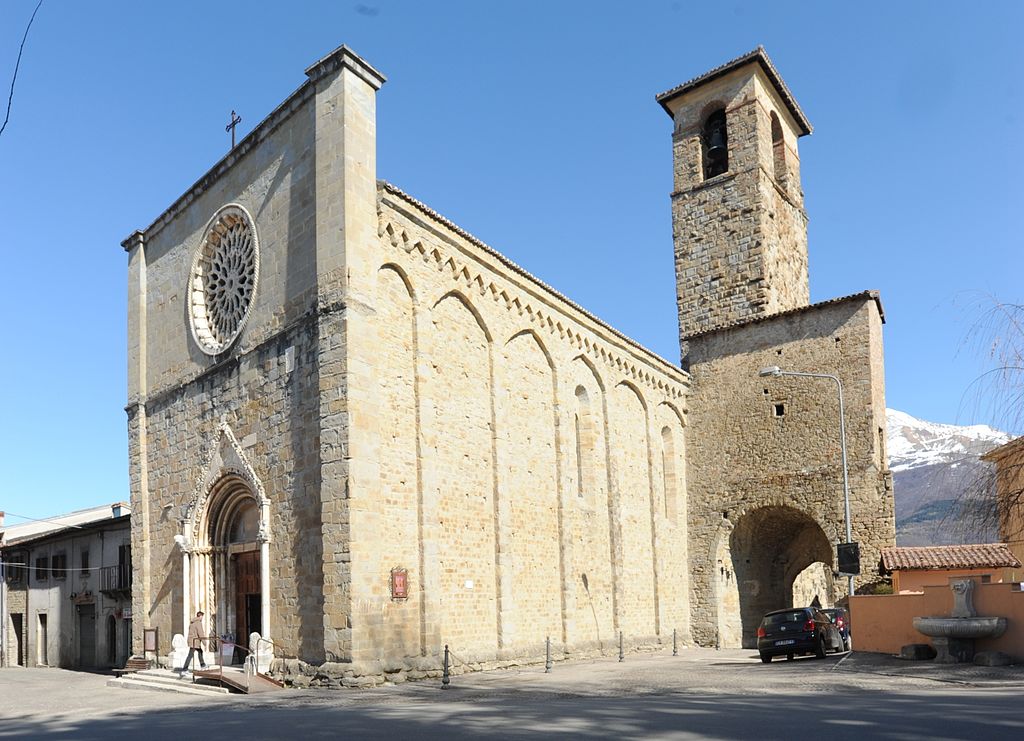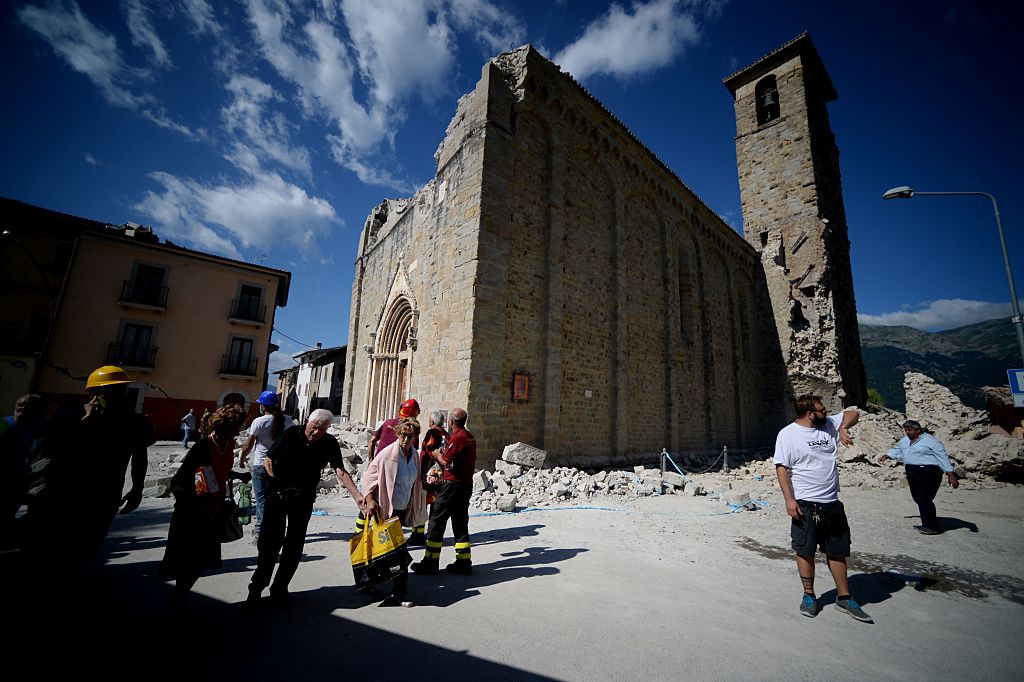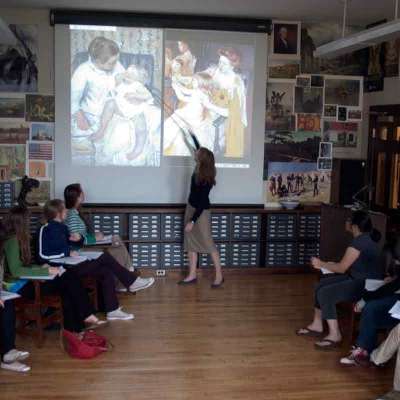On 24 August 2016 a devastating earthquake struck central Italy. 298 lives were lost. After L’Aquila (2009) and Emilia (2012), the latest seismic events threaten the survival of Italian cultural heritage once again.
This time Amatrice and Accumoli (Lazio) as well as Arquata del Tronto (Marche) are the centres most affected by the disaster. These lovely towns, lying by the consular road, the Via Salaria, are rich in history, art and architecture. The valley of Amatrice was involved in the spread of Franciscan movement early on and, by virtue of its position, played a strategic role as a political and commercial crossroads between the Kingdom of Naples and the Papal States. Accumoli is noteworthy not only for its churches, but also for medieval and Renaissance palaces, while Arquata, rising on a hill on the left side of the Tronto river, is known particularly for its Rocca, a medieval fortress with a hexagonal tower and a dungeon.
The Church of Sant’Agostino in Amatrice in 2012. Photo: Wikimedia commons

There are many ancient churches in Amatrice, among which Sant’Agostino and San Francesco – at the eastern and southern limits, respectively, of the historical town centre – stand out with their sandstone façades and late gothic portals. A single-nave edifice under a fully exposed truss ceiling with a vaulted apse, the latter is a typical Franciscan ‘barn-church’ which preserves several late medieval frescoes: large fragments of a Last Judgement (1380–90) are still visible on both sides of the 17th-century altar of Madonna di Filetta.
The church of Sant’Emidio is dedicated to the patron of saint Ascoli Piceno – invoked against earthquakes – to whose Diocese Amatrice belonged until 1965. The building, no longer officiated, now houses the Museo Civico Cola Filotesio, dedicated to the prominent painter and architect of the Renaissance Cola dell’Amatrice. His Holy Family on panel (1527) is one of the highlights of the museum, together with 15th-century metal artworks attributed to the goldsmith Pietro Paolo Vannini: the Reliquary of Filetta from the church of San Francesco, and two processional crosses from the villages of Pinaco and Preta. Filetta is a village in the Amatrice area with a famous sanctuary frescoed by Pier Paolo da Fermo and local painters. Another revered sanctuary in this territory is Santa Maria delle Grazie at Ferrazza, popularly called ‘Cona Passatora’ for its frescoed Madonna adored as a miraculous image by shepherds and passing wayfarers. But for each of these highlights, there are dozens of other historic buildings, too.
Photo: FILIPPO MONTEFORTE/AFP/Getty Images

After the earthquake the Ministry of Culture immediately set up four regional crisis units coordinated by the Secretariats for damage assessment and recovery of cultural heritage in the affected regions of Abruzzo, Lazio, Marche and Umbria. These crisis units consist of teams of architects, engineers and art historians, supported by the fire department with the task of monitoring the conservation status of monuments and works of art. There are 16 municipalities inside the area of the seismic crater, and in a recent speech on 10 October, the head of Italy’s Heritage Security Commission, Fabio Carapezza Gattuso, confirmed that around 1,500 buildings had been damaged – hundreds severely. But many areas close to the epicentre have yet to be reached, and technicians are still evaluating the effects of the earthquake on more peripheral areas – so a clear and complete picture of the situation has yet to emerge.
Securing the buildings themselves is a long and difficult process, and it is really too early to set strategies and time-schedules for the reconstruction. One of the more immediate tasks for the crisis units has been the recovery of works of art. The frescoes of Cona Passatora have been protected in situ, but many other wall paintings await interventions. Meanwhile, portable works of art are being removed to safe locations. In , steps have been taken to secure the works contained in the church of Sant’Agostino and the paintings of the Museo Civico. Drones were deployed by the Fire Department to survey the churches of San Francesco and Sant’Agostino, making subsequent recovery efforts possible and safer. Removal operations have also been initiated in nearby small towns: both the bronze bell of the church of the Madonna del Latte in Rocchetta and furnishings of the church of Sant’Emidio in Poggio Vitellino were successfully recovered.
Firefighters recover a religious painting from a damaged church in the village of Rio, some 10 kms from the central Italian village of Amatrice, on August 28, 2016. ALBERTO PIZZOLI/AFP/Getty Images

In Accumoli the church of San Francesco was particularly badly damaged: the earthquake caused the bell tower to collapse as well as part of the apse wall and the facade, and the recovery operations have been correspondingly complex. Among the various works of art in need of assistance are: the great altarpiece depicting the Ecstasy of St. Francis from the first half of the 17th century, the Immaculate Conception of the 16th century and Our Lady of Mercy and the Saints of the second quarter of the 17th century, attributed to Alessandro Turchi (also known as Orbetto). The teams were also able to rescue the 17th-century polychrome wooden statues and the liturgical furnishings from the church of Santa Maria della Misericordia and a valuable silver processional cross, dated to the 16th century, from the church of Madonna delle Coste just outside the town centre.
The paintings and furniture saved from Accumoli and Amatrice have been brought temporarily to a storage unit of the School of the Forestry Corps in Cittaducale. In the other regions affected by the earthquake, steps are being taken to identify middle- to long-term storage facilities for displaced artworks. In the Marche region, the Ministry is assessing the compatibility of the spaces of Forte Malatesta of Ascoli Piceno: in the meantime some of the artworks removed from the churches of Arquata del Tronto have been transferred to a warehouse owned by the Diocese of Ascoli Piceno.
Until a complete evaluation of the damages is complete, we can only ask questions concerning the future reconstruction. What additional steps will be taken to remove debris and to recover fragments? Will the temporary storages locations be opened to the public? How will official guidelines for the mitigation of seismic risk to cultural heritage sites be applied? Italy must resolve to take a systematic approach to risk assessment and prevention, if it is to protect its own cultural heritage from future natural disasters.
Editor’s note: Since this article was published, several major tremors have struck central Italy, including the regions worst affected by the August disaster. Several people were injured – a few seriously – in the quakes, the first of which struck on 26 October, and several buildings are reported to have been damaged or collapsed. We will report on further developments from the region in Art News Daily.
Amatrice’s priest Father Savino, holds a santon of the “Madonna of Filetta” found in the ruins of the Sant’Agostino church on 30 August, 2016 in Amatrice. ANDREAS SOLARO/AFP/Getty Images



